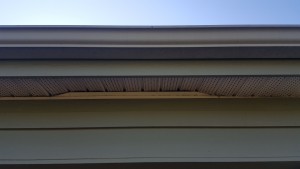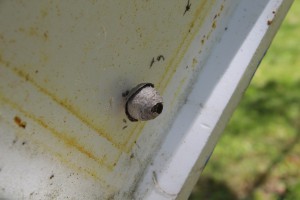It’s spring fever. That is what the name of it is. And when you’ve got it, you want — oh, you don’t quite know what it is you do want, but it just fairly makes your heart ache, you want it so! — Mark Twain
For IPMers who answer homeowner questions, what many people want in spring is an answer to dandelions. These in-your-face, bright bursts of yellow are speckling lawns statewide. Homeowners that aren’t yet convinced how important these early flowers are to pollinators want them gone — now. The bad news (or good, depending on your perspective) is: it’s not the best time to do anything. The best time to control broad-leafed weeds is late summer and fall. (We covered this a couple of years ago: Dandelions – Love Them or Leave Them, but Don’t Spray Them.)
We have exactly the opposite problem with wasps and yellow jackets. Now is the time to prevent later problems because their populations are so low in spring.

Last autumn a homeowner had “a swarm of bees” take residence in the attic. A pest management professional removed the nest and sprayed an insecticide. When “the bees” were noted this spring, the homeowner worried that they were back for a repeat performance.
The homeowner admitted that he didn’t know if it was bees, yellow jackets, or paper wasps. Identification matters when deciding how to deal with a large active population (you can find pictures of different types of stinging insects here and a video here). But no matter what type of insect is currently scoping out his house, the IPM solution is the same. Find the opening and seal it properly. (Unless it’s a carpenter bee. For more information on them, check out our Get Rid of Carpenter Bees? Yes, Please! fact sheet.)

In the case of our nervous homeowner, a damaged soffit provides access for all sorts of critters. (The soffit connects the outside wall with the overhang on your roof.) Forget stinging insects. The 1/4″ to 1/2″gap is large enough for bats and mice to enter. (Mice are good climbers.) This is relatively easy to repair by reseating the soffit flush with the bottom. To learn more about sealing openings, you can’t go wrong with the NYS IPM publication Beasts Begone! A Practitioner’s Guide to IPM in Buildings.

Along with inspecting your house and outbuildings for openings that provide access to stinging insects, take the time you’d have spent on dandelions to watch for queens starting new nests under decks and eaves. These small nests can be easily removed using a broom handle or stream of water. (We covered this last year: Inspect for Wasps and Avoid the Sting.)
Looking for yet more info on stinging insects? Seek no further: NYS IPM’s Stinging Insect IPM video and What’s Bugging You page.